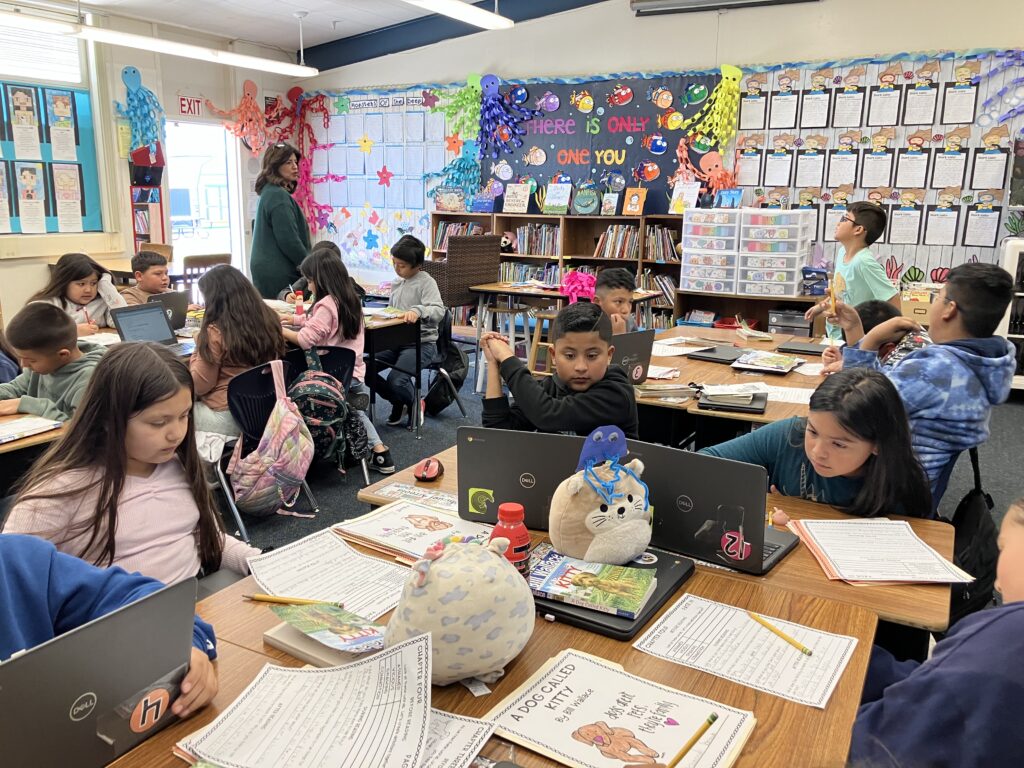
EdSource file photo courtesy of Oakland School for the Arts
Este artículo está disponible en Español. Léelo en español.
Vicky Martinez feels cheated that her children haven’t had much exposure to the arts at their Los Angeles Unified (LAUSD) schools despite state funding through Proposition 28, the state’s landmark arts education mandate. She believes access to the arts could help them cope with their anxiety and ADHD, conditions that have spiked post-pandemic.
“I had more arts than my kids do,” said Martinez, mother of three LAUSD students in the Highland Park area. “That’s not right. It makes me angry that our kids are being denied the arts when there’s been so much research about how it keeps kids engaged in school. We should be making progress, and instead we are lagging behind.”
Many parents share her outrage. The families of eight students, including Martinez’s three sons, 12, 15 and 17, and the author of the arts proposition have joined forces to file a lawsuit against Los Angeles Unified School District, the nation’s second-largest school district, and its superintendent, Alberto Carvalho. The lawsuit, filed Monday afternoon in Los Angeles County Superior Court, alleges misuse of funds as well as misleading the public in its rollout of Proposition 28 that sets aside roughly $1 billion a year statewide for arts education.
“LAUSD has willfully and knowingly violated the law,” said former LAUSD Superintendent Austin Beutner, who authored the proposition, “and as a consequence, is harming hundreds of thousands of students by depriving them of the arts education that they are entitled to under law.”
The suit also claims that LAUSD’s mismanagement of Proposition 28 funds, particularly at low-income schools , has disproportionately impacted Black and Latino students, deepening inequity. The thrust of the law, says Beutner, is that all students, not just privileged ones, deserve access to the arts.
“We have not received notice, nor have we been served with any lawsuit regarding Prop 28,” an LAUSD spokesperson said in a statement to EdSource. “That said, we have sought to clarify any misunderstandings regarding Prop 28, and we continue to follow implementation guidance as provided by the state of California to ensure that we are fully complying with the requirements of Prop 28.”
The suit is the latest push for accountability on arts education funding. Beutner and a group of major unions, including UTLA, the local teachers union, SEIU Local 99 and Teamsters 572, wrote a letter to education officials last year demanding the state hold districts responsible for their spending. LAUSD was allotted roughly $77 million for arts education in the 2023-24 school year.
The unions are helping pay for the lawsuit, which comes at a time when the district is already facing mounting scrutiny over its handling of three large cyberattacks exposing sensitive student information and the appropriateness of its response to recent catastrophic fires.
“LAUSD has done exactly what the law prohibits,” the suit argues; “it has eliminated existing funding sources for existing art teachers, and replaced those funds with Proposition 28 funds, thereby violating the requirement that the funds supplement rather than supplant existing sources. Moreover, LAUSD has made no meaningful effort to recruit or hire new art teachers as required by the law.”
Given extensive research that arts education has key academic and social benefits, the law was designed to hire new arts teachers, and most schools are required to spend at least 80% of funds on staff. The plaintiffs allege that the district has been willfully misinterpreting the law and misleading families and teachers.
“Bottom line, there’s been rampant misuse of the funds,” Beutner said, “and the guidance and oversight has been insufficient.”
In an Aug. 15, 2024, memo to the board, Carvalho acknowledged spending new Proposition 28 money to pay for existing staff, which is not allowed.
“Given historic staffing challenges in filling Arts educator roles and because 80% of Prop 28 must be spent on labor, the District prioritized the use of Prop 28 funds to cover existing staff as well as hire new staff.”
The district argues that the law only requires an increase in arts funding for the district as a whole.
“The law requires that non-Prop. 28 arts expenditures at the district level are higher than previous years and does not factor in differences in spending at a school site level,” according to an LAUSD fact sheet.
Beutner has long objected to this interpretation. The law requires that every school to increase its arts offerings, he maintains, so that all students have access.
Cecily Myart-Cruz, the president of UTLA, the union representing about 35,000 LAUSD educators, claims the district has not been honest about its use of Prop 28 funds.
“The superintendent pulling out a bulletin saying, ‘Oops, my bad,’ doesn’t work,” Myart-Cruz said. “If you have arts in school, you will change lives. … And so, I’m exasperated by the district’s lack of response and responsibility to providing arts educators for our babies and the communities in which we serve.”
To be sure, similar issues have arisen across the state. Facing budget woes, some schools have used creative bookkeeping maneuvers to pay existing staff with the new funds, instead of actually adding arts teachers, experts warn.
“The temptation to redirect these funds can arise when schools face financial pressures in other areas,” said Allison Gamlen, visual and performing arts coordinator for the San Mateo County Office of Education. “This is a clear violation of the intent of the proposition and, unfortunately, not an isolated incident.”
However, many other districts across the state, from Pacifica to Long Beach, have successfully used the proposition funds to build robust new arts ed programs, experts note.
That disparity explains why many parents and teachers have been calling for greater transparency in how schools use the arts money, which landed in schools in February 2024.
“We want real support for the hiring of folks who can provide arts instruction, and I think that this is the righteous thing. This is the legal thing,” said Nicolle Fefferman, a veteran LAUSD teacher, who also co-founded the Parents Supporting Teachers advocacy group. “Who does this money serve sitting in a district bank account?”
Families want a seat at the table.
“At many schools, there was no conversation about Prop. 28,” said Martinez. “Parents had no input.”
Make no mistake, the impact of any misspent funds on families can be severe. Martinez said that her 15-year-old son, going by the alias Julian in the suit, suffers from severe anxiety and feelings of despair, conditions she believes could be alleviated by the therapeutic influence of the arts. When her oldest son got his hands on a guitar, she says, he started to thrive.
“Arts improves learning, especially for low-income students,” said Martinez. “We are hurting them by not providing it.”
Another plaintiff’s mother, going by the alias April T., says her son, going by Lucas, 9, only gets one hour a week of art class, the same as before Proposition 28. She says she pays for private music classes because none are available through LAUSD.
Accountability is among the most critical issues facing the Proposition 28 rollout, according to a recent report by Arts for LA, a key arts advocacy organization.
“Teachers, parents and students should know whether, how, and when Prop 28 decisions are being made,” said Lindsey Kunisaki, who wrote the report. “They’ll be the ones to directly experience the impact of those Prop 28 decisions in practice, and moreover, they’re the experts in the realities of their own classrooms and communities.”
Carvalho’s August memo also acknowledges that the district did not “consult with school communities specifically about Prop 28 Arts funding,” but will encourage principals to solicit feedback going forward.
Many experts recommend an independent oversight committee of administrators, teachers, families and community partners to make sure that arts education funds are properly spent. Some may assume that county offices of education provide oversight, but that is not within their purview, experts say.
Arts education advocates have long urged the California Department of Education (CDE), which is administering the new funding, to step up enforcement of the rules. Many have complained that the department has not provided enough guidance to schools already struggling with myriad post-pandemic issues.
“The structure of the proposition did not include any provision to ensure adequate CDE staffing to address questions and the overall confusion that has been a common thread,” said Allison Cagley, executive director of Friends of Sacramento Arts, an advocacy group. “There was no one or two people at CDE that could adequately address the questions.”
CDE officials could not be immediately reached for comment.
Amid the controversy, many parents are anxious to see Proposition 28 funds put to good use to spark engagement at a time of chronic absenteeism and widespread disaffection at schools.
“This is an investment in our kids,” Martinez said. “Our kids deserve this. We all agreed on this. The state of California voted for this. So why aren’t we doing it?”





